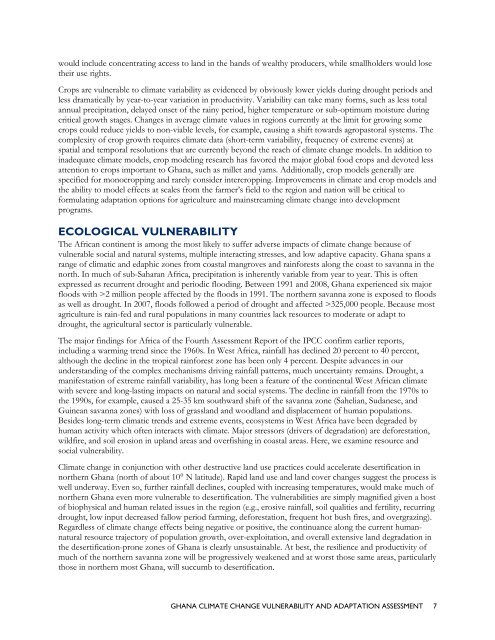ghana climate change vulnerability and adaptation assessment
ghana climate change vulnerability and adaptation assessment
ghana climate change vulnerability and adaptation assessment
- No tags were found...
You also want an ePaper? Increase the reach of your titles
YUMPU automatically turns print PDFs into web optimized ePapers that Google loves.
would include concentrating access to l<strong>and</strong> in the h<strong>and</strong>s of wealthy producers, while smallholders would losetheir use rights.Crops are vulnerable to <strong>climate</strong> variability as evidenced by obviously lower yields during drought periods <strong>and</strong>less dramatically by year-to-year variation in productivity. Variability can take many forms, such as less totalannual precipitation, delayed onset of the rainy period, higher temperature or sub-optimum moisture duringcritical growth stages. Changes in average <strong>climate</strong> values in regions currently at the limit for growing somecrops could reduce yields to non-viable levels, for example, causing a shift towards agropastoral systems. Thecomplexity of crop growth requires <strong>climate</strong> data (short-term variability, frequency of extreme events) atspatial <strong>and</strong> temporal resolutions that are currently beyond the reach of <strong>climate</strong> <strong>change</strong> models. In addition toinadequate <strong>climate</strong> models, crop modeling research has favored the major global food crops <strong>and</strong> devoted lessattention to crops important to Ghana, such as millet <strong>and</strong> yams. Additionally, crop models generally arespecified for monocropping <strong>and</strong> rarely consider intercropping. Improvements in <strong>climate</strong> <strong>and</strong> crop models <strong>and</strong>the ability to model effects at scales from the farmer’s field to the region <strong>and</strong> nation will be critical toformulating <strong>adaptation</strong> options for agriculture <strong>and</strong> mainstreaming <strong>climate</strong> <strong>change</strong> into developmentprograms.ECOLOGICAL VULNERABILITYThe African continent is among the most likely to suffer adverse impacts of <strong>climate</strong> <strong>change</strong> because ofvulnerable social <strong>and</strong> natural systems, multiple interacting stresses, <strong>and</strong> low adaptive capacity. Ghana spans arange of climatic <strong>and</strong> edaphic zones from coastal mangroves <strong>and</strong> rainforests along the coast to savanna in thenorth. In much of sub-Saharan Africa, precipitation is inherently variable from year to year. This is oftenexpressed as recurrent drought <strong>and</strong> periodic flooding. Between 1991 <strong>and</strong> 2008, Ghana experienced six majorfloods with >2 million people affected by the floods in 1991. The northern savanna zone is exposed to floodsas well as drought. In 2007, floods followed a period of drought <strong>and</strong> affected >325,000 people. Because mostagriculture is rain-fed <strong>and</strong> rural populations in many countries lack resources to moderate or adapt todrought, the agricultural sector is particularly vulnerable.The major findings for Africa of the Fourth Assessment Report of the IPCC confirm earlier reports,including a warming trend since the 1960s. In West Africa, rainfall has declined 20 percent to 40 percent,although the decline in the tropical rainforest zone has been only 4 percent. Despite advances in ourunderst<strong>and</strong>ing of the complex mechanisms driving rainfall patterns, much uncertainty remains. Drought, amanifestation of extreme rainfall variability, has long been a feature of the continental West African <strong>climate</strong>with severe <strong>and</strong> long-lasting impacts on natural <strong>and</strong> social systems. The decline in rainfall from the 1970s tothe 1990s, for example, caused a 25-35 km southward shift of the savanna zone (Sahelian, Sudanese, <strong>and</strong>Guinean savanna zones) with loss of grassl<strong>and</strong> <strong>and</strong> woodl<strong>and</strong> <strong>and</strong> displacement of human populations.Besides long-term climatic trends <strong>and</strong> extreme events, ecosystems in West Africa have been degraded byhuman activity which often interacts with <strong>climate</strong>. Major stressors (drivers of degradation) are deforestation,wildfire, <strong>and</strong> soil erosion in upl<strong>and</strong> areas <strong>and</strong> overfishing in coastal areas. Here, we examine resource <strong>and</strong>social <strong>vulnerability</strong>.Climate <strong>change</strong> in conjunction with other destructive l<strong>and</strong> use practices could accelerate desertification innorthern Ghana (north of about 10° N latitude). Rapid l<strong>and</strong> use <strong>and</strong> l<strong>and</strong> cover <strong>change</strong>s suggest the process iswell underway. Even so, further rainfall declines, coupled with increasing temperatures, would make much ofnorthern Ghana even more vulnerable to desertification. The vulnerabilities are simply magnified given a hostof biophysical <strong>and</strong> human related issues in the region (e.g., erosive rainfall, soil qualities <strong>and</strong> fertility, recurringdrought, low input decreased fallow period farming, deforestation, frequent hot bush fires, <strong>and</strong> overgrazing).Regardless of <strong>climate</strong> <strong>change</strong> effects being negative or positive, the continuance along the current humannaturalresource trajectory of population growth, over-exploitation, <strong>and</strong> overall extensive l<strong>and</strong> degradation inthe desertification-prone zones of Ghana is clearly unsustainable. At best, the resilience <strong>and</strong> productivity ofmuch of the northern savanna zone will be progressively weakened <strong>and</strong> at worst those same areas, particularlythose in northern most Ghana, will succumb to desertification.GHANA CLIMATE CHANGE VULNERABILITY AND ADAPTATION ASSESSMENT 7
















